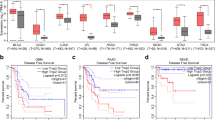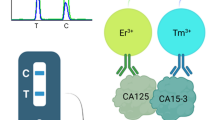Abstract
Glycosylated PD-L1 is a more reliable biomarker for immune checkpoint therapy and plays important roles in tumor immunity. Glycosylation of PD-L1 hinders antibody-based detection, which is partially responsible for the inconsistency between PD-L1 immunohistochemical results and therapeutic treatment response. Herein, we present a proximity ligation assay mediated rolling circle amplification (PLA-RCA) strategy for amplified imaging of glycosylated PD-L1 in situ. The strategy relies on a pair of DNA probes: an aptamer probe to specifically recognize cellular surface protein PD-L1 and a glycan conversion (GC) probe for metabolic glycan labeling. Upon proximity ligation of sequence binding to the two probes, the proximity ligation–triggered RCA occurs. The feasibility of the as-proposed strategy has been validated as it realized the visualization of PD-L1 glycosylation in different cancer cells and the monitoring of the variation of PD-L1 glycosylation during drug treatment. Thus, we envision the present work offers a useful alternative to track protein-specific glycosylation and potentially advances the investigation of the dynamic glycan state associated with the disease process.







Similar content being viewed by others
References
Barkeer S, Chugh S, Batra SK, Ponnusamy MP. Glycosylation of cancer stem cells: function in stemness, tumorigenesis, and metastasis. Neoplasia. 2018;20(8):813–25.
Chang MM, Gaidukov L, Jung G, Tseng WA, Scarcelli JJ, Cornell R, et al. Small-molecule control of antibody N-glycosylation in engineered mammalian cells. Nat Chem Biol. 2019;15(7):730–6.
He CH, Lee CG, Ma B, Kamle S, Choi AM, Elias JA. N-glycosylation regulates chitinase 3–like-1 and IL-13 ligand binding to IL-13 receptor α2. Am J Respir Cell Mol Biol. 2020;63(3):386–95.
Liu K, Tan S, Jin W, Guan J, Wang Q, Sun H, et al. N-glycosylation of PD-1 promotes binding of camrelizumab. EMBO Rep. 2020;21(12):e51444.
Hsu J-M, Li C-W, Lai Y-J, Hung M-C. Posttranslational modifications of PD-L1 and their applications in cancer therapy. Cancer Res. 2018;78(22):6349–53.
Shao B, Li C-W, Lim S-O, Sun L, Lai Y-J, Hou J, et al. Deglycosylation of PD-L1 by 2-deoxyglucose reverses PARP inhibitor-induced immunosuppression in triple-negative breast cancer. Am J Cancer Res. 2018;8(9):1837.
Strauch V, Saul D, Berisha M, Mackensen A, Mougiakakos D, Jitschin R. N-glycosylation controls inflammatory licensing-triggered PD-L1 upregulation in human mesenchymal stromal cells. Stem Cells. 2020;38(8):986–93.
Wang Y-N, Lee H-H, Hsu JL, Yu D, Hung M-C. The impact of PD-L1 N-linked glycosylation on cancer therapy and clinical diagnosis. J Biomed Sci. 2020;27(1):1–11.
Lee H-H, Wang Y-N, Xia W, Chen C-H, Rau K-M, Ye L, et al. Removal of N-linked glycosylation enhances PD-L1 detection and predicts anti-PD-1/PD-L1 therapeutic efficacy. Cancer Cell. 2019;36(2):168–78. e4.
Lim H, Chun J, Jin X, Kim J, Yoon J, No KT. Investigation of protein-protein interactions and hot spot region between PD-1 and PD-L1 by fragment molecular orbital method. Sci Rep. 2019;9(1):1–11.
Sidaway P. Deglycosylated PD-L1 might be a better biomarker. Nature Reviews Clinical Oncology. 2019;16(10):592.
Xu J, Yang X, Mao Y, Mei J, Wang H, Ding J, et al. Removal of N-linked glycosylation enhances PD-L1 detection in colon cancer: validation research based on immunohistochemistry analysis. Technol Cancer Res Treat. 2021;20:15330338211019442.
Li N, Zhang W, Lin L, Shah SNA, Li Y, Lin J-M. Nongenetically encoded and erasable imaging strategy for receptor-specific glycans on live cells. Anal Chem. 2019;91(4):2600–4.
Chen Y, Ding L, Song W, Yang M, Ju H. Protein-specific Raman imaging of glycosylation on single cells with zone-controllable SERS effect. Chem Sci. 2016;7(1):569–74.
Zhao T, Masuda T, Miyoshi E, Takai M. High dye-loaded and thin-shell fluorescent polymeric nanoparticles for enhanced FRET imaging of protein-specific sialylation on the cell surface. Anal Chem. 2020;92(19):13271–80.
Li Z, Yuan B, Lin X, Meng X, Wen X, Guo Q, et al. Intramolecular trigger remodeling-induced HCR for amplified detection of protein-specific glycosylation. Talanta. 2020;215:120889.
Yang X, Tang Y, Zhang X, Hu Y, Tang YY, Hu LY, et al. Fluorometric visualization of mucin 1 glycans on cell surfaces based on rolling-mediated cascade amplification and CdTe quantum dots. Microchim Acta. 2019;186(11):1–9.
Li J, Liu S, Sun L, Li W, Zhang S-Y, Yang S, et al. Amplified visualization of protein-specific glycosylation in zebrafish via proximity-induced hybridization chain reaction. J Am Chem Soc. 2018;140(48):16589–95.
Feng C, Mao X, Yang Y, Zhu X, Yin Y, Li G. Rolling circle amplification in electrochemical biosensor with biomedical applications. J Electroanal Chem. 2016;781:223–32.
Gao F, Zhou F, Chen S, Yao Y, Wu J, Yin D, et al. Proximity hybridization triggered rolling-circle amplification for sensitive electrochemical homogeneous immunoassay. Analyst. 2017;142(22):4308–16.
Ge J, Hu Y, Deng R, Li Z, Zhang K, Shi M, et al. Highly sensitive microRNA detection by coupling nicking-enhanced rolling circle amplification with MoS2 quantum dots. Anal Chem. 2020;92(19):13588–94.
Hamidi SV, Perreault J. Simple rolling circle amplification colorimetric assay based on pH for target DNA detection. Talanta. 2019;201:419–25.
Jiang H-X, Zhao M-Y, Niu C-D, Kong D-M. Real-time monitoring of rolling circle amplification using aggregation-induced emission: applications in biological detection. Chem Commun. 2015;51(92):16518–21.
Joffroy B, Uca YO, Prešern D, Doye JPK, Schmidt TL. Rolling circle amplification shows a sinusoidal template length-dependent amplification bias. Nucleic Acids Res. 2018;46(2):538–45.
Shen C, Liu S, Li X, Yang M. Electrochemical detection of circulating tumor cells based on DNA generated electrochemical current and rolling circle amplification. Anal Chem. 2019;91(18):11614–9.
Xu J, Guo J, Maina SW, Yang Y, Hu Y, Li X, et al. An aptasensor for Staphylococcus aureus based on nicking enzyme amplification reaction and rolling circle amplification. Anal Biochem. 2018;549:136–42.
Xu L, Duan J, Chen J, Ding S, Cheng W. Recent advances in rolling circle amplification-based biosensing strategies-a review. Anal Chim Acta. 2020.
Zhang J, He M, Nie C, He M, Pan Q, Liu C, et al. Biomineralized metal–organic framework nanoparticles enable enzymatic rolling circle amplification in living cells for ultrasensitive MicroRNA imaging. Anal Chem. 2019;91(14):9049–57.
Zhou Y, Li B, Wang M, Wang J, Yin H, Ai S. Fluorometric determination of microRNA based on strand displacement amplification and rolling circle amplification. Microchim Acta. 2017;184(11):4359–65.
Cheng B, Xie R, Dong L, Chen X. Metabolic remodeling of cell-surface sialic acids: principles, applications, and recent advances. Chembiochem. 2016;17(1):11–27.
Jaiswal M, Tran TT, Li Q, Yan X, Zhou M, Kundu K, et al. A metabolically engineered spin-labeling approach for studying glycans on cells. Chem Sci. 2020;11(46):12522–32.
Huang M, Yang J, Wang T, Song J, Xia J, Wu L, et al. Homogeneous, low-volume, efficient, and sensitive quantitation of circulating exosomal PD-L1 for cancer diagnosis and immunotherapy response prediction. Angew Chem. 2020;132(12):4830–5.
Li C-W, Lim S-O, Chung EM, Kim Y-S, Park AH, Yao J, et al. Eradication of triple-negative breast cancer cells by targeting glycosylated PD-L1. Cancer Cell. 2018;33(2):187–201. e10.
Li C-W, Lim S-O, Xia W, Lee H-H, Chan L-C, Kuo C-W, et al. Glycosylation and stabilization of programmed death ligand-1 suppresses T-cell activity. Nat Commun. 2016;7(1):1–11.
Zhu L, Xu Y, Wei X, Lin H, Huang M, Lin B, et al. Coupling aptamer-based protein tagging with metabolic glycan labeling for in situ visualization and biological function study of exosomal protein-specific glycosylation. Angew Chem. 2021;60(33):18111–5.
Funding
This work was supported by the National Natural Science Foundation of China (No. 81672112, 81972025).
Author information
Authors and Affiliations
Corresponding author
Ethics declarations
Conflict of interest
The authors declare no competing interests.
Additional information
Publisher’s note
Springer Nature remains neutral with regard to jurisdictional claims in published maps and institutional affiliations.
Supplementary information
ESM 1
(DOCX 264 kb)
Rights and permissions
About this article
Cite this article
Fu, Y., Qian, H., Zhou, X. et al. Proximity ligation assay mediated rolling circle amplification strategy for in situ amplified imaging of glycosylated PD-L1. Anal Bioanal Chem 413, 6929–6939 (2021). https://doi.org/10.1007/s00216-021-03659-z
Received:
Revised:
Accepted:
Published:
Issue Date:
DOI: https://doi.org/10.1007/s00216-021-03659-z




